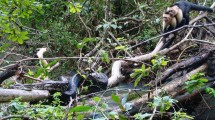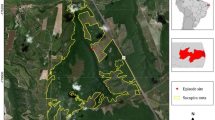Abstract
Here we report the first witnessed attack on a marmoset by a constrictor snake. The incident occurred mid-morning in a gallery forest within an altered landscape of the Cerrado region of central Brazil and refers to a fatal attack by a Boa constrictor on two juvenile black-tufted-ear marmosets (Callithrix penicillata) simultaneously. The snake captured both individuals at a height of ~4 m while a group of eight marmosets traveled through the subcanopy. The actual strike was not seen. After 2 min, the boa fell to the ground with both marmosets in its coils and proceeded to kill one animal at a time through constriction. Two adult marmosets immediately descended to where the snake held its victims on the ground and attacked it. The snake showed no apparent reaction, and after ~1–2 min, the adults rejoined the remaining group members that were mobbing and vocalizing from 5 to 6 m above. The group left the scene ~7 min after the onset of the attack and was not seen again. The snake loosened its coils 10 min after its initial strike, left the two carcasses on the ground and stayed behind a nearby tree. Thus, we are not sure if the victims were in fact ingested. This report confirms that marmosets are vulnerable to boid snakes and capable of highly organized and cooperative antipredation behavior. It also suggests that snakes pose a greater threat to callitrichids than previously thought.

Similar content being viewed by others
References
Barros M, Boere V, Mello EL Jr, Tomaz C (2002) Reactions to potential predators in captive-born marmosets (Callithrix penicillata). Int J Primatol 23:443–454
Barros M, Alencar C, Tomaz C (2004) Differences in aerial and terrestrial visual scanning in captive black tufted-ear marmosets (Callithrix penicillata) exposed to a novel environment. Folia Primatol 75:85–92
Bartecki U, Heymann E (1987) Field observations of snake mobbing in a group of saddleback tamarins, Saguinus fuscicollis nigrifrons. Folia Primatol 48:199–202
Bianchi RC, Mendes SL (2007) Ocelot (Leopardus pardalis) predation on primates in Caratinga Biological Station, southeast Brazil. Am J Primatol 69:1173–1178
Chapman CA (1986) Boa constrictor predation and group response in white-faced cebus monkeys. Biotropica 18:171–172
Cheney DL, Wrangham RW (1987) Predation. In: Smuts BB, Cheney DL, Seyfarth RM, Wrangham RW, Struhsaker TT (eds) Primate societies. The University of Chicago Press, Chicago, pp 227–239
Corrêa HKM, Coutinho PEG (1997) Fatal attack of a pit viper, Bothrops jararaca, on an infant buffy-tufted ear marmoset (Callithrix aurita). Primates 38:215–217
Crofoot MC (2012) Why mob? Reassessing the costs and benefits of primate predator harassment. Folia Primatol 83:252–273
de Luna AG, Sanmiguel R, Di Fiore A, Fernandez-Duque E (2010) Predation and predation attempts on red titi monkeys (Callicebus discolor) and equatorial sakis (Pithecia aequatorialis) in Amazonian Ecuador. Folia Primatol 81:86–95
Eberle M, Kappeler PM (2008) Mutualism, reciprocity, or kin selection? Cooperative rescue of a conspecific from a boa in a nocturnal solitary forager the gray mouse lemur. Am J Primatol 70:410–414
Etting SF, Isbell LA, Grote MN (2014) Factors increasing snake detection and perceived threat in captive rhesus macaques (Macaca mulatta). Am J Primatol 76:135–145
Ferrari SF (2009) Predation risk and antipredator strategies. In: Garber PA, Estrada A, Bicca-Marques JC, Heymann EK, Strier KB (eds) South American primates: comparative perspectives in the study of behavior, ecology, and conservation. Springer, New York, pp 251–277
Ferrari SF, Beltrão-Mendes R (2011) Do snakes represent the principal predatory threat to callitrichids? Fatal attack of a viper (Bothrops leucurus) on a common marmoset (Callithrix jacchus) in the Atlantic Forest of the Brazilian Northeast. Primates 52:207–209
Gardner CJ, Radolalaina P, Rajerison M, Greene HW (2015) Cooperative rescue and predator fatality involving a group-living strepsirrhine, Coquerel’s sifaka (Propithecus coquereli), and a Madagascar ground boa (Acrantophis madagascariensis). Primate 56:127–129
Greene HW (1983) Boa constrictor (boa, béquer, boa constrictor). In: Janzen DH (ed) Costa Rican natural history. University of Chicago Press, Chicago, pp 380–382
Gursky S (2002) Predation on a wild spectral tarsier (Tarsius spectrum) by a snake. Folia Primatol 73:60–62
Heymann EW (1987) A field observation of predation on a moustached tamarin (Saguinus mystax) by an anaconda. Int J Primatol 8:193–195
Hilário RR, Ferrari SF (2015) Dense understory and absence of capuchin monkeys (Sapajus xanthosternos) predict higher density of common marmosets (Callithrix jacchus) in the Brazilian Northeast. Am J Primatol 77:425–433
Kierulff MC, Raboy BE, Oliveira PP, Miller K, Passos FC, Prado F (2002) Behavioral ecology of lion tamarins. In: Kleiman DG, Rylands AB (eds) Lion tamarins: biology and conservation. Smithsonian Institution Press, Washington, pp 157–187
Lledo-Ferrer Y, Hidalgo A, Heymann EW, Pelaéz F (2009) Field observation of predation of a slate-colored hawk, Leucopternis schistacea, on a juvenile saddle-back tamarin, Saguinus fuscicollis. Neotrop Primates 16:82–84
Nievergelt CM, Digby LJ, Ramakrishnan U, Woodruff DS (2000) Genetic analysis of group composition and breeding system in a wild common marmoset (Callithrix jacchus) population. Int J Primatol 21:1–20
Perry S, Manson JH, Dower G, Wikberg E (2003) White-faced capuchins cooperate to rescue a groupmate from a Boa constrictor. Folia Primatol 74:109–111
Pizzatto L, Marques OAV, Facure K (2009) Food habits of Brazilian boid snakes: overview and new data, with special reference to Corallus hortulanus. Amphibia-Reptilia 30:533–544
Quintino EP, Bicca-Marques JC (2013) Predation of Alouatta puruensis by Boa constrictor. Primates 54:325–330
Stafford BJ, Ferreira FM (1995) Predation attempts on callitrichids in the Atlantic Coastal Rain Forest of Brazil. Folia Primatol 65:229–233
Stanford CB (2002) Avoiding predators: expectations and evidence in primate antipredator behaviour. Int J Primatol 23:741–757
Tello NS, Huck M, Heymann EW (2002) Boa constrictor attack and successful defence in moustached tamarins, Saguinus mystax. Folia Primatol 73:146–148
Tórrez L, Robles N, Gonzáelz A, Crofoot MC (2012) Risky business? Lethal attack by a jaguar sheds light on the costs of predator mobbing for capuchins (Cebus capucinus). Int J Primatol 33:440–446
Vasquez MRO, Heymann EW (2001) Crested eagle (Morphnus guianensis) predation on infant tamarins (Saguinus mystax and Saguinus fuscicollis, Callitrichinae). Folia Primatol 72:301–303
Acknowledgments
This study was supported by the Brazilian Ministry of Health (SVS/MS). MB received a researcher fellowship from the Brazilian National Research Council (CNPq 303331/2012-7). These funding sources had no involvement in the study design, data collection, analysis or interpretation, writing the manuscript, or decision to submit it for publication. The authors would like to thank GT-Arbo (Grupo Técnico das Arboviroses/SVS/MS), the Flavivirus Laboratory (Fiocruz, Brazil), and the Health Departments of the state of Goiás and of the city of Campos Belos, Brazil, for their technical and logistical support, as well as two anonymous reviewers for their helpful comments on the original version of the manuscript.
Author information
Authors and Affiliations
Corresponding author
Ethics declarations
Conflict of interest
The authors declare that they have no conflict of interest.
Ethical approval
This article does not contain any studies with human participants or animals performed by any of the authors.
About this article
Cite this article
Teixeira, D.S., dos Santos, E., Leal, S.G. et al. Fatal attack on black-tufted-ear marmosets (Callithrix penicillata) by a Boa constrictor: a simultaneous assault on two juvenile monkeys. Primates 57, 123–127 (2016). https://doi.org/10.1007/s10329-015-0495-x
Received:
Accepted:
Published:
Issue Date:
DOI: https://doi.org/10.1007/s10329-015-0495-x




